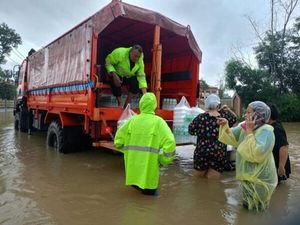On the night of September 9, 2025, a chilling scene unfolded at the family home of Bhimlal Adhikari in Kathmandu: nearly 40 men, their identities obscured by masks and motorcycle helmets, arrived in the darkness. This ominous visit signaled the intensity of unrest gripping Nepal in the wake of the Gen Z protest movement—a wave of youth-led demonstrations that would soon leave the nation reeling from violence, political upheaval, and a crisis of accountability.
Just days later, on September 17, candles flickered in front of Nepal’s Federal Parliament House. Mourners gathered to remember the lives lost during a week of chaos that saw 76 people killed and 2,429 injured, according to official counts reported by the Associated Press. The violence, unleashed by both security forces and enraged mobs, marked one of the darkest chapters in Nepal’s recent history.
At the heart of the turmoil was a simple yet explosive demand: justice. Gen Z activists and the families of victims pressed the new Prime Minister, Sushila Karki, to hold officials from the previous government accountable for the killings—particularly the murder of 19 young protesters outside Parliament on September 8. The pressure was palpable. Yet, as Nepali Times observed, prosecuting former leaders risked sparking further unrest, with the threat of street protests looming over every political calculation.
Former Prime Minister KP Sharma Oli, ousted and bristling with resentment, emerged as a formidable obstacle to any reckoning. Rather than retreating, Oli took to the streets, organizing rallies and signaling his readiness to resist prosecution. His party, the UML, formed a new Youth Volunteer Force, led by figures with controversial pasts, including former Maoist Pushparaj Shrestha—accused of multiple murders and kidnappings. Mahesh Basnet, a former MP, fanned the flames further with incendiary remarks on social media, warning of consequences if the government pursued charges against Oli or his allies.
"Oli is obviously using the threat of street protests as a deterrent: don’t come after me, or else," wrote Kunda Dixit in Nepali Times. The stakes were high for Prime Minister Karki, who had to balance demands for justice with the risk of escalation that could derail upcoming elections or even plunge the country into deeper crisis.
Meanwhile, the political landscape was shifting in unpredictable ways. The Nepali Congress, once a dominant force, found itself in disarray, with leader Sher Bahadur Deuba wavering over his resignation and internal factions demanding sweeping reforms. The Maoists, once revolutionaries, had splintered and regrouped, with some forming the new Nepali Communist Party and others, like Baburam Bhattarai, leading parties pledging to champion the Gen Z cause. Yet, as Nepali Times noted, these legacy parties seemed oblivious to the depth of public outrage, clinging to old power structures and sidelining younger voices.
In the midst of this political drama, a judicial commission led by former Chief Justice Gauri Bahadur Karki began its investigation. The panel, established to probe the deaths and destruction during the Gen Z movement, faced immediate resistance. Former Prime Minister Oli flatly refused to recognize the commission or provide a statement. "There is no obligation to accept them as an impartial commission. I am an independent citizen. I act with conscience," Oli declared, as reported by Republica. He insisted that while a probe was necessary, the current commission was biased and prejudiced against him and his party. "Recognizing such a commission would be foolish. I will not recognize it. UML will not recognize it."
The commission, undeterred, pressed forward. Both Oli and his former Home Minister, Ramesh Lekhak, were barred from leaving the Kathmandu Valley, with plans underway to summon them for statements. Lekhak, who had resigned on the morning of September 9—just hours after 22 people were shot dead—expressed a cautious willingness to cooperate. "There has been no notice, no call; if they call, we will think about what to do," he told Republica. A private secretary clarified, "if summoned, Lekhak will attend."
Over the following weeks, the commission collected evidence, questioned security officials and civil servants, and took statements from key figures, including Rastriya Swatantra Party Chair Rabi Lamichhane, former National Investigation Department chief Hut Raj Thapa, and Sudurpaschim DIG Om Rana, who had been acting chief of Kathmandu Valley Police on September 8. Yet, significant obstacles remained. The Nepal Army refused to cooperate, citing the chain of command and insisting it would address any internal faults independently. The police, for their part, initially declined to share information about commanders on duty, prompting the commission to impose a Rs 500 fine and make the standoff public.
The Human Rights Watch report, released last week, cast a harsh light on the events of September 8 and 9. It documented that the Special Task Force began shooting within five minutes of a curfew being announced—without warning. Many protesters, unaware of the curfew, were caught in the crossfire. Thirty-four were detained inside Parliament, where, according to the report, they were beaten and mentally tortured. The wounded and dead bore high-velocity gunshot wounds to their heads, chests, and abdomens. The following day’s arson and looting, investigators found, had been instigated by a mass SMS from a fake Myagdi account, with Discord posts directing attacks on specific locations.
Public anger only grew as the Home Ministry focused on arresting those responsible for arson and looting, while failing to pursue the shooters. Home Minister Om Aryal stated he was waiting for the judicial commission’s report before taking action. But for many, this was cold comfort. The question on everyone’s lips: who gave the order to use lethal force, and why did the Army not intervene sooner?
As the commission’s deadline approached—just one month left as of November 27—Nepal stood at a crossroads. The investigation’s findings could reshape the country’s political future, but only if leaders are willing to confront uncomfortable truths. With the specter of further violence hanging over the capital, and the memory of flickering candles still fresh, the challenge for Nepal’s leaders is not just to reckon with the past, but to chart a path toward real accountability and lasting peace.
It’s a test of leadership, courage, and the ability to learn from tragedy—a test Nepal cannot afford to fail.





